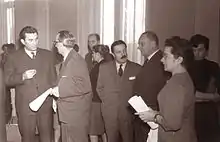Socialist Alliance of Working People of Yugoslavia
The Socialist Alliance of Working People of Yugoslavia or SSRNJ (Serbo-Croatian: Socijalistički savez radnog naroda Jugoslavije/Социјалистички савез радног народа Југославије, SSRNJ/ССРНЈ, Slovene: Socialistična zveza delovnega ljudstva Jugoslavije, SZDLJ, Macedonian: Социјалистички сојуз на работниот народ на Југославија, ССРНЈ), formerly the People's Front (Narodni Front or NOF in Serbo-Croatian, Ljudska fronta or LF in Slovene), was the largest and most influential mass organization in SFR Yugoslavia from August 1945 through 1990. In 1990 its membership was thirteen million, including most of the adult population of the country.
Socijalistički savez radnog naroda Jugoslavije | |
 | |
| Formation | August 1945 |
|---|---|
| Dissolved | 1990 |
| Headquarters | Belgrade |
| Location |
|
Membership | 13,000,000 |
President | Veljko Milatović |
The political purpose of this national organization, sponsored by the League of Communists of Yugoslavia (SKJ), was to involve as many people as possible in activities on the party agenda, without the restrictions and negative connotations of direct party control. The SSRNJ also was chartered as a national arbitration forum for competing, cross-regional interests. Although party officials were forbidden to hold simultaneous office in SSRNJ, the top echelon of the latter was dominated by established party members. The importance of SSRNJ to the party leadership increased as the party's direct control over social and state institutions decreased. It was useful in mobilizing otherwise apathetic citizens during the Croatian crisis of 1971 and the Kosovo crisis of 1987.[1]
The Constitution stipulated a wide variety of social and political functions for SSRNJ, including nomination of candidates for delegate at the commune level, suggesting solutions to national and local social issues to assembly delegates, and overseeing elections and public policy implementation. Both individuals and interest groups held membership. The structure of SSRNJ was very similar to that of the party, including a hierarchy that extended from national to commune level. SSRNJ organizations in the republics and provinces were simplified versions of the national structure.[1]
The national organization was run by a conference of delegates chosen by the regional SSRNJ leadership. The conference presidium included members from the party, the armed forces, trade unions, Socialist Youth League, and other national organizations. Like the SKJ Central Committee, the SSRNJ conference established departments to formulate policy recommendations in areas such as economics, education, and sociopolitical relations. Coordinating committees were also active in interregional consultation on policy and mass political action.[1]

In SR Slovenia, the Socialist Alliance became an umbrella organization for a number of nonparty organizations with political interests, beginning in 1988. On a lesser scale, similar changes occurred in other republics. This development rekindled the idea that SSRNJ might be divorced from SKJ domination and reconstituted as a second political party at the national level. Pending such an event, SSRNJ was regarded throughout the 1980s as a puppet of the party elite, particularly by virtue of its exclusive control over the nomination of assembly delegates at the commune level.[1]
One of the Presidents of the Federal Conference was Veljko Milatović.
Notes
- Text used in this cited section originally came from: Former Yugoslavia Country Study from the Library of Congress Country Studies project.
References
 This article incorporates public domain material from the Library of Congress Country Studies website http://lcweb2.loc.gov/frd/cs/.
This article incorporates public domain material from the Library of Congress Country Studies website http://lcweb2.loc.gov/frd/cs/.